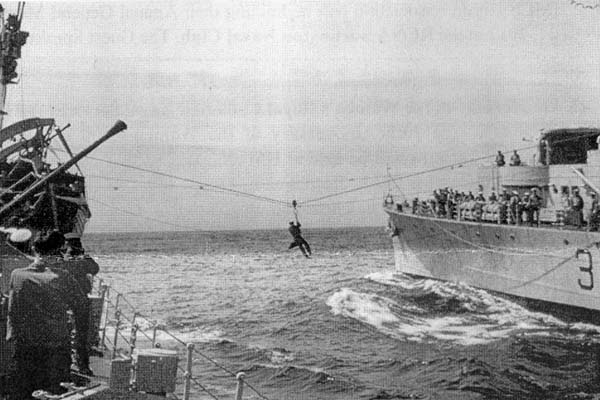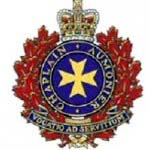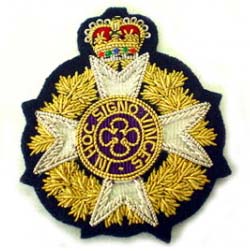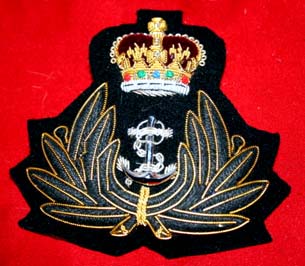by The Reverend Cannon William Thomas SLt (N) Ret'd
![]()
![]()
Except for command ships or squadron leaders, ships of the RCN did not normally have a chaplain aboard. As such, the chaplain would move from ship to ship to conduct services by jackstay transfer, often carrying, in addition to a bible, prayer book and personal gear, a large sack containing mail, and reels of l6 mm films (chief form of entertainment before television and satellite connections) - a pretty heavy load.The chaplain would be quartered with the officers, usually sharing a cabin with a junior officer. While he would often take his meals in the Wardroom, he was also welcome to eat in any of the messes. Originally, chaplains held no rank at all. Chaplains were often addressed as 'Padre' (Spanish for "Father"), and, less respectfully, as a 'Sin Bos'n'.
Originating in the British Royal Navy, it is a custom to baptize a person with the bell used as a christening bowl, filled with water for the ceremony. It is usually placed, upside down, clapper removed, in a wooden cradle, which is then covered with the naval ensign. Once the baptism is completed, the water is discharged over the side, accompanied by all of the honours (pipes, salute) that would accompany a burial at sea. This symbolizes that the 'old person' has been left behind in the water, while a person made new in faith, continues on. The names of those baptized on board are inscribed on the exterior of the bell. The bell remains with the ship while in service and with the Ministry of Defence after decommissioning. Bells have been loaned or provided to churches as memorials to those vessels; this practice has been largely replaced by displaying bells with namesake municipalities, with museums, and with naval commands and vessels. In this way, an invisible tie is created between the country and its citizens.
When on board, the chaplain's chief responsibility was, in consultation with the captain, the morale of the crew which was exercised through private counselling; mediation; arranging whenever possible, shipboard entertainment such as films, 'talent' shows, contests, etc., and conducting worship services on Sunday, and special occasions such as before and after battle, rescue etc., baptism, marriages, and burials. Chaplains also advise senior officers on issues of religion, ethics, troop morale and morals, while also functioning as liaisons to local religious leaders at ports of call in an effort to understand the role of religion as both a factor in hostility and war and as a force for reconciliation and peace. During battle stations or other emergencies, the chaplain was assigned to the sick bay to assist with treatment, to offer support through prayer and conversation, to administer the last rites, etc.
 |
| The light jackstay is used for transferring personnel,
provisions, light stores and has a maximum transfer load of 250 kg. The
hauling end of the jackstay is manned by at least 25 men (28 in high sea
states) and the other end is secured by a grommet strop to a slip in the
receiving ship. The traveller block is hauled back and forth along
the jackstay by an outhaul in the receiving ship and by an inhaul in the
delivering ship, manned by 6 men in each ship. Working distance limits
of the rig are 24 to 61 metres with a normal working distance of 34 metres.
The standard transfer rate is 35 loads per hour in reasonable weather conditions,
and the fleet Standard Time for evolution (ie First Line Gun line to test
weight hooked on in the supplying ship). This is called the Setup and from
'Last Load unhooked' to 'All Clear' (The Disassemble) is around 10
minutes.
The above photo shows a midshipman being run between two Prestonian Class frigates, carrying a standard RAS bag, with lifejacket attached. His foot rests in the eye splice of a 2.5m rope secured to the travelling block, and he grips the upper portion of the line with both hands. It is considered very bad form, although it has been known to happen, to 'wet' the transferee by slacking off on the jackstay. (RCN photo) |
 |
| This the current Chaplaincy Branch Badge. The new motto is "Calling and Service" and the new corps hymn is "Ode to Joy" replacing "Onward Christian Soldier". There are different symbols in the centre of the badge depending on the sponsoring faith. |
 |
| This was the RCN Chaplains badge of the Chaplaincy Corps from its inception until 2002. It was usually worn on the base of the black "Preaching Scarf" or "tippet' and as a blazer badge. The motto "In hoc signo vincit" translates as "conquer in this sign". |
 |
| Royal Navy Chaplain's Badge. In the Royal Navy, chaplains continue to wear officer's dress, but without rank or insignia and distinguished only by a cap badge in which the normal officer's oak leaves were replaced by black laurel leaves. |
| All images in this table courtesy William Thomas |
Chaplains were part of the Chaplaincy Corps. Up until 1968, Chaplains held no rank and were welcome in all messes. After 1968, they held the rank of Lieutenant in the Navy, and Major in the Army and Air force. They also wore collar tabs consisting of either a cross, star of David, or crescent, to distinguish their accrediting faith group.In 2002 the two divisions within the Chaplaincy Branch – Roman Catholic and Protestant – began the process of amalgamating their two separate classifications, Chaplain (RC) and Chaplain (P), into a single military occupation. What had once been two parallel but distinct Roman Catholic and Protestant Chaplain Branches, has now merged into a single ecumenical and now multi-faith Chaplain Branch. New Branch insignia, motto and emblems were created, and Ode to Joy was approved as the new Branch March, replacing Onward Christian Soldiers.
 |
| Church pennant: The broad pennant combination of the English Flag at the hoist and the Dutch National Flag in the fly, originated from the Anglo-Dutch wars of the late 17th century. On Sundays, to indicate that a service was in progress and a ceasefire existed between the warring nations, the pennant was raised. Today, it is flown from the starboard yardarm whenever a religious service (worship, baptism, marriage, burial, memorial ) is being held on board. (Image courtesy www.crwflags.com) |
USING BIBLICAL QUOTES WHEN SENDING MESSAGES
There was a well founded tradition in the Royal Navy and in the Royal Canadian Navy of using Biblical quotations as shorthand for sending messages. The Chaplain’s presence on board, and his familiarity with the Bible and its word index (called a ‘Concordance’ ) was especially helpful in locating a useful phrase which could be quickly communicated by Morse Code in a naval message using only a biblical book, chapter, and verse.
Many pithy, witty or just plain snippy words to the wise were relayed via Biblical quotes, which had the virtue of being concise, to the point, and suitable for a range of occasions and eventualities. References to quotations (i.e. 1 Corinthians 15-33) were used singly or as part of a longer message. Brevity was especially important during wartime. Most signals sent at sea during World War II were conveyed using light or by radio. The sender had to keep messages short, for the sake of efficiency and security.Even those unfamiliar with scripture were able to use this technique, thanks to a portable digest of Biblical chapter and verse known as a "vade mecum". Latin for ‘go with me’, vade mecum refers to a handbook that is carried on the person and consulted as required. Equipped with a copy of this handbook, even people who were not scholars of the Bible could borrow its verses to make a point or deliver a rebuke.
In any case, some knowledge of the Bible was almost a given during the period when such handbooks were in use. Many schoolchildren received a good grounding in scriptural chapter and verse, whether they received this education at school, Sunday school, home, or all three. Thus the ship's Captain, signalmen, or personnel working on the bridge took advantage of Biblical writings to make a few short words go a very long way. It became almost a craze among senior escort officers in Britain's Royal Navy to embed Biblical references in their signals.
Examples of such exchanges include the following:
1) From a submarine returning from war patrol to the flotilla Captain:
o Psalm 17, verse 4 "Concerning the works of men by the word of thy lips I have kept me from the2) Reply to signal received by an officer, congratulating him on his promotion:
path of the destroyers"
o Psalm 140, 2nd half of verse 5 "They have set gins for me"Situations when Bible quotes were used were many and varied. These occasions might include:3) When a ship collided with the jetty while docking:
o Proverbs 22-28 "Remove not the ancient landmark which thy fathers have set"4) When a ship was not keeping proper ‘station’; station being the location to which a ship or fleet is
assigned for duty:o Psalm 77-19 "Thy way is in the sea and thy path in the great waters and thy footsteps are not known"5) To reprimand someone who hadn't followed instructions properly, or disobeyed them entirely:
o Proverbs 4-26 "Ponder the path of thy feet and let all thy ways be established"o Job 31-11 "For this is a heinous crime, yea it is an iniquity to be punished by the judges"6) To request a report on a particular action or event:
o Proverbs 8-33 "Hear instruction and be wise and refuse it not"o Revelations 1-19 "Write the things which thou hast seen, and the things which are and the7) To give direction:
things which shall be hereafter"o Deuteronomy 2-3 "Ye have compassed this mountain long enough, turn ye northward"8) To chide someone who was overly concerned with promoting his own career or prospects:o Psalm 75-6 "For promotion cometh neither from the east nor from the west not from the south"9) When one ship said goodbye to another ship:o Acts 21-6 "And when we had taken our leave of one another, we took ship, and they returned home again"The content of such Biblically-based messages was often light-hearted, but it could also be serious:10) In the case of a victory at sea:
o Psalm 18-37 "I have pursued mine enemies and overtaken them, neither did I turn again until11) By way of a warning against rebellious behaviour by crew members:
they were consumed"o Philippians 3-14 "Do all things without murmurings and disputings"12) A treasured example, was this signal sent by the C-in-C, Plymouth to a corvette towing a damaged
merchantman: "ROMAN EMPEROR IN TOW, BADLY DAMAGED, PLEASE SEND TUGS". From C-in-C, Plymouth:o Revelations 3:11.- “Behold, I come quickly; hold that fast To give direction:
Credits and Contributors:1) William Thomas <thomasbj3(at)sympatico.ca>
2) History of Canadian Military Chaplaincy http://www.anglican.ca/amo/history/
|
|
Aug 15/13